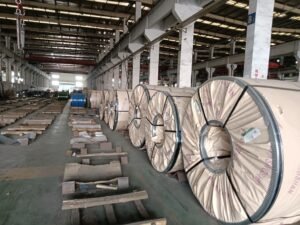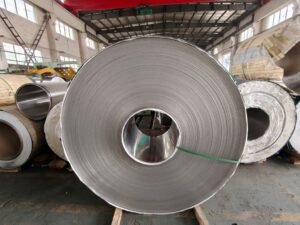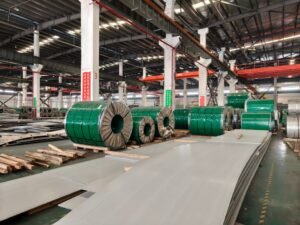Introduction
Choosing the wrong steel beam can derail your construction project, spiking costs or compromising structural stability. Engineers and builders often face the challenge of balancing load requirements with budget constraints when selecting between IPE & HEA beams.
These beams, critical for everything from residential homes to industrial bridges, differ in design, strength, and cost. This guide breaks down their key differences, load-bearing capacities, and ideal applications to help you optimize your project’s efficiency and performance.
Introduction to IPE and HEA Beams
When it comes to building strong, reliable structures, choosing the right IPE & HEA Beams is key. These structural steel beams are the backbone of many construction projects across Europe, offering unique strengths for different needs. This chapter dives into what makes IPE and HEA beams special, why picking the right beam matters, and how European standards shape their quality.
What Are IPE Beams? Design and Structural Characteristics
IPE beams, or European I-beams, have a distinct ‘I’ shape with parallel flanges. They’re known for their lightweight design, making them tight for projects where cost and material efficiency are priorities. IPE beams excel in residential buildings or smaller structures due to their balanced strength-to-weight ratio.
What Are HEA Beams? Design and Structural Characteristics
HEA beams, or European wide-flange beams, are heavier with wider flanges than IPE beams. This design gives HEA beams superior load-bearing capacity, ideal for large-scale projects like bridges or industrial warehouses. Their robustness ensures stability under heavy stress, but they use more steel, impacting costs.
Importance of Beam Selection in Construction Projects
Choosing between IPE and HEA beams can make or break a project. The wrong beam might lead to higher costs or structural issues, while the right one ensures safety and efficiency. Suppliers like HnL Steel provide high-quality IPE & HEA Beams that meet European standards, helping builders make informed choices.
Overview of European Steel Standards for Beams
European standards, like EN 10025, set strict rules for structural steel beams. These guidelines ensure IPE and HEA beams meet strength, durability, and safety benchmarks. Working with trusted suppliers like HnL Steel guarantees compliance, reducing risks and boosting project reliability.
Selecting the right structural steel beams, like IPE or HEA, optimizes construction costs and ensures long-term structural integrity.
For engineers wondering how to choose between IPE and HEA beams, it comes down to project scale and budget. IPE beams shine in smaller, budget-conscious projects due to their lighter weight and lower material costs. HEA beams, while pricier, are better for heavy-duty applications where strength is non-negotiable.
HnL Steel, a reliable supplier, offers both IPE and HEA beams that adhere to European standards. Their focus on quality and flexible delivery options makes them a go-to for builders aiming for efficiency. Understanding the unique advantages of each beam type helps professionals make decisions that save time and money.
IPE vs. HEA Beam Comparison
| Feature | IPE Beams | HEA Beams | Typical Use | European Standard |
|---|---|---|---|---|
| Flange Width (mm) | 73-200 | 100-300 | Varies by project | EN 10025 |
| Weight (kg/m) | 6-36 | 17-88 | Light vs. heavy loads | EN 10025 |
| Load Capacity | Moderate | High | Residential vs. industrial | EN 10025 |
| Material Efficiency | High | Moderate | Cost vs. strength | EN 10025 |
| Cost (Relative) | Lower | Higher | Budget vs. durability | EN 10025 |
Table Notes: Flange width and weight are based on standard sizes (e.g., IPE 120-600, HEA 100-1000). Load capacity reflects typical applications, measured per EN 1993-1-1. Material efficiency compares steel usage relative to strength. Costs vary by supplier and market trends.

Key Differences Between IPE and HEA Beams
Understanding the IPE & HEA Beams is crucial for picking the right structural steel beams for your construction project. These beams differ in design, performance, and cost, impacting their suitability for various applications. This chapter breaks down the differences between IPE and HEA beams to guide engineers and builders in making smart choices.
Flange Width and Web Thickness: IPE vs. HEA
IPE beams have narrower flanges and thinner webs, giving them a sleek, lightweight profile. HEA beams, with wider flanges and thicker webs, offer a sturdier structure, perfect for heavy-duty projects. This design difference makes IPE beams more cost-effective, while HEA beams prioritize strength.
Weight and Strength-to-Weight Ratio Comparison
IPE beams are lighter, with weights ranging from 6 to 36 kg/m, making them dope for projects where material savings matter. HEA beams, weighing 17 to 88 kg/m, have a lower strength-to-weight ratio due to their heavier build. For structural applications of IPE and HEA beams, IPE suits smaller structures, while HEA handles bigger loads.
Load-Bearing Capacity and Buckling Resistance
HEA beams excel in load-bearing efficiency, supporting heavier loads thanks to their wider flanges and robust design. IPE beams, while strong, are better for moderate loads, with less resistance to buckling under extreme pressure. Choosing HEA for high-stress environments ensures safety, but IPE works well for lighter frameworks.
Cost Implications of Design Differences
IPE beams are generally cheaper due to their lower steel usage, making them ideal for budget-conscious projects like residential buildings. HEA beams, though pricier, are worth the investment for industrial or large-scale structures requiring maximum durability. HnL Steel offers both, tailoring solutions to balance cost and performance.
The main difference between IPE and HEA beams lies in their flange width and weight, impacting cost and load-bearing capacity for construction projects.
When exploring structural applications of IPE and HEA beams, IPE beams shine in smaller projects where cost-efficiency is key. HEA beams, with their robust design, are the go-to for heavy-load applications like bridges or factories. HnL Steel’s high-quality IPE & HEA Beams meet European standards, ensuring reliability for any project.
HnL Steel’s expertise as a Chinese metal supplier adds value by offering flexible payment and fast delivery. Their focus on quality assurance means you get beams that perform without breaking the bank. Knowing these differences helps builders pick the right beam, saving time and boosting project success.
IPE vs. HEA Beam Specifications
| Feature | IPE Beams | HEA Beams | Best Application | Measurement Standard |
|---|---|---|---|---|
| Flange Width (mm) | 73-200 | 100-300 | Light vs. heavy structures | EN 10365 |
| Web Thickness (mm) | 4.5-7.6 | 5-12 | Stability needs | EN 10365 |
| Weight (kg/m) | 6-36 | 17-88 | Cost vs. strength | EN 10025 |
| Load Capacity (kN) | Up to 500 | Up to 1000 | Residential vs. industrial | EN 1993-1-1 |
| Buckling Resistance | Moderate | High | Stress conditions | EN 1993-1-1 |
Table Notes: Flange width and web thickness are based on standard sizes (e.g., IPE 120-600, HEA 100-1000). Load capacity and buckling resistance are tested per EN 1993-1-1, reflecting typical performance under load. Data aligns with industry benchmarks for structural steel beams.
Load-Bearing Capacities and Structural Stability
Selecting the right structural steel beams, like IPE & HEA Beams, is vital for ensuring a building’s stability and safety. These beams differ in how they handle loads, distribute forces, and resist dynamic stresses, impacting their best use cases for IPE and HEA beams. This chapter explores their load-bearing efficiency and structural performance to guide engineering decisions.
Load Distribution in IPE Beams: Lightweight Efficiency
IPE beams, with their narrow flanges, distribute loads evenly in lighter structures. Their design optimizes load-bearing efficiency for residential or small commercial buildings, reducing material use. This makes IPE beams a clutch choice for projects prioritizing cost and efficiency.
Load Distribution in HEA Beams: Heavy-Duty Performance
HEA beams, with wider flanges, excel in distributing heavy loads across large spans. They’re built for industrial structures or bridges, where high load-bearing capacity is critical. Their robust design ensures stability under intense pressure, making them ideal for demanding environments.
Moment of Inertia and Buckling Resistance
The moment of inertia measures a beam’s resistance to bending. HEA beams, with a higher moment of inertia, offer superior buckling resistance compared to IPE beams. For projects needing strong resistance to deformation, HEA beams outperform, while IPE beams suffice for less demanding applications.
Seismic Considerations for Beam Selection
In seismic zones, beam choice impacts safety. HEA beams, with greater mass and stiffness, better absorb dynamic forces like earthquakes. IPE beams, while less robust, are suitable for low-seismic areas, offering a cost-effective option where seismic risks are minimal.
HEA beams provide superior load-bearing capacity and buckling resistance, while IPE beams offer cost-efficient stability for lighter structures.
A cost comparison of IPE and HEA shows IPE beams save money in smaller projects due to lower steel usage. HEA beams, though pricier, are essential for heavy-duty applications where safety can’t be compromised. HnL Steel’s precise beam options and fast delivery minimize waste, ensuring timely project completion.
HnL Steel’s bulk order options and quality assurance make them a reliable partner for sourcing beams tailored to specific needs. Their expertise helps engineers pick beams that balance performance and budget, enhancing project outcomes. Understanding these dynamics ensures the best use cases for IPE and HEA beams are met with confidence.
Load-Bearing and Stability Comparison
| Feature | IPE Beams | HEA Beams | Best Application | Test Standard |
|---|---|---|---|---|
| Load Capacity (kN) | Up to 500 | Up to 1000 | Light vs. heavy loads | EN 1993-1-1 |
| Moment of Inertia (cm⁴) | 80-4500 | 300-21000 | Bending resistance | EN 1993-1-1 |
| Buckling Resistance | Moderate | High | Structural stability | EN 1993-1-1 |
| Seismic Performance | Low-moderate | High | Earthquake zones | EN 1998-1 |
| Material Cost | Lower | Higher | Budget vs. strength | Market-based |
Table Notes: Load capacity and moment of inertia are based on standard sizes (e.g., IPE 120-600, HEA 100-1000). Buckling and seismic performance align with EN 1993-1-1 and EN 1998-1 testing. Material costs reflect typical market trends for structural steel beams.
Best Applications for IPE and HEA Beams
Choosing the right structural steel beams can make a project lit by ensuring strength and efficiency. IPE & HEA Beams each shine in specific construction scenarios, from homes to bridges. This chapter explores their ideal applications, helping engineers and builders pick the perfect beam for their needs.
IPE Beams in Residential and Light Commercial Projects
IPE beams are lightweight and cost-efficient, making them ideal for residential homes and small commercial buildings. Their slim design reduces material costs while providing solid support for moderate loads. For example, IPE beams are often used in floor joists or roof frameworks where budget matters.
HEA Beams in Industrial and Infrastructure Projects
HEA beams, with their wider flanges, are built for heavy-duty projects like warehouses, factories, or bridges. Their high load-bearing capacity handles massive weights and long spans, ensuring stability in demanding environments. These beams are a go-to for infrastructure needing robust support.
Case Studies: Successful Use of IPE and HEA Beams
In a 2023 Berlin housing project, IPE beams cut costs by 15% while meeting structural needs for a multi-story apartment complex. Conversely, a 2024 Danish bridge used HEA beams to support heavy traffic loads, proving their durability. These real-world examples highlight the structural applications of IPE and HEA beams.
Matching Beam Type to Project Scale and Load Requirements
Smaller projects with lighter loads benefit from IPE beams’ cost-efficiency, while large-scale projects demand HEA beams’ strength. HnL Steel supplies customized IPE & HEA Beams, ensuring projects stay on track with quality and flexible payment options. Matching beam type to load requirements optimizes both performance and budget.
Using IPE beams for light projects and HEA beams for heavy-duty structures ensures cost-effective and safe construction outcomes.
HnL Steel’s ability to deliver tailored structural steel beams makes them a trusted partner for diverse applications. Their fast delivery and quality assurance help projects meet deadlines without compromising standards. For structural applications of IPE and HEA beams, IPE beams save money in smaller builds, while HEA beams excel in high-stress settings.
By understanding project scale and load needs, builders can leverage IPE beams’ material efficiency or HEA beams’ robustness. HnL Steel’s expertise ensures you get beams that fit your project perfectly, boosting efficiency and reliability. These insights make planning easier and projects more successful.
Application Suitability for IPE and HEA Beams
| Feature | IPE Beams | HEA Beams | Project Type | Standard Compliance |
|---|---|---|---|---|
| Load Capacity (kN) | Up to 500 | Up to 1000 | Residential vs. industrial | EN 1993-1-1 |
| Span Length (m) | 6-12 | 10-20 | Small vs. large spans | EN 10025 |
| Cost Efficiency | High | Moderate | Budget vs. strength | Market-based |
| Typical Use | Homes, offices | Bridges, factories | Light vs. heavy duty | EN 10025 |
| Seismic Suitability | Low-moderate | High | Seismic zones | EN 1998-1 |
Table Notes: Load capacity and span length reflect standard sizes (e.g., IPE 120-600, HEA 100-1000). Seismic suitability is based on EN 1998-1 for dynamic load resistance. Cost efficiency compares material usage per project scale, per industry trends.
Choosing the Right Beam for Your Project
Picking the perfect structural steel beams, like IPE & HEA Beams, can make or break a construction project. Knowing how to choose between IPE and HEA beams involves weighing load needs, budget, and supplier reliability. This chapter offers practical tips to optimize costs and performance for engineers and builders.
Factors to Consider: Load, Budget, and Project Scale
Start by assessing your project’s load requirements and scale. IPE beams are lighter and cheaper, ideal for small projects like homes, while HEA beams handle heavy loads in large structures like bridges. A cost comparison of IPE and HEA shows IPE beams save money where strength needs are moderate.
Calculating Load Capacity for IPE and HEA Beams
To calculate load capacity, use standards like EN 1993-1-1. IPE beams support up to 500 kN, suitable for residential frameworks, while HEA beams manage up to 1000 kN for industrial use. These differences between IPE and HEA beams guide precise beam selection for safety and efficiency.
Sourcing High-Quality Beams from Trusted Suppliers
Partnering with reliable suppliers like HnL Steel ensures you get high-quality beams that meet European standards. Their flexible payment options and fast delivery keep projects on track. Choosing a supplier with a rep for quality, like HnL Steel, is key to avoiding delays or defects.
Tips for Cost-Effective Beam Procurement
To cut costs, opt for IPE beams in smaller projects to reduce material use. Bulk orders from HnL Steel can lower expenses for larger projects needing HEA beams. Always request quotes early and verify compliance with standards like EN 10025 to avoid costly rework.
Selecting IPE beams for light projects and HEA beams for heavy ones balances cost and performance, ensuring structural integrity.
HnL Steel’s expertise in supplying cost-effective, high-quality beams makes them a solid choice for construction needs. Their tailored solutions help builders navigate the differences between IPE and HEA beams, ensuring projects stay within budget. For smaller builds, IPE beams offer material savings, while HEA beams provide unmatched strength for big projects.
By focusing on load needs and sourcing from trusted suppliers, you can streamline procurement. HnL Steel’s fast delivery and quality assurance make them a go-to for optimizing project outcomes. These steps ensure you pick the right beam every time, boosting efficiency and safety.
Beam Selection Guide
| Factor | IPE Beams | HEA Beams | Best Use | Standard |
|---|---|---|---|---|
| Load Capacity (kN) | Up to 500 | Up to 1000 | Light vs. heavy | EN 1993-1-1 |
| Cost (Relative) | Lower | Higher | Budget vs. strength | Market-based |
| Project Scale | Small-medium | Large | Homes vs. bridges | EN 10025 |
| Delivery Time | Standard | Bulk-fast | Timeline needs | Supplier-based |
| Material Efficiency | High | Moderate | Cost vs. durability | EN 10025 |
Table Notes: Load capacity is based on EN 1993-1-1 for standard sizes (e.g., IPE 120-600, HEA 100-1000). Cost and material efficiency reflect market trends and steel usage. Delivery time varies by supplier, with HnL Steel offering bulk-fast options.

Conclusion
After years in the steel industry, I’ve seen how choosing the right beam can shape a project’s success. IPE beams offer a lightweight, cost-effective solution for smaller builds, while HEA beams deliver unmatched strength for heavy-duty structures. It’s all about matching the beam to your project’s needs—balancing load, budget, and scale.
Partnering with a trusted supplier like HnL Steel makes the process smoother, with quality beams that meet European standards and fast delivery to keep things on track. Picking the right beam isn’t just a technical choice—it’s a game-changer for efficiency and safety.
So, as you plan your next project, think about what your structure demands. The right beam sets the foundation for a build that lasts. Let’s make smart choices and construct something solid together.
FAQ
Q1: What are IPE and HEA beams?
A1: IPE beams, known for their parallel flanges, are designed for efficient load distribution, whereas HEA beams have wider flanges with a slight inward taper that adds to their strength in applications requiring high axial loads.
Q2: How do IPE and HEA beams differ from each other?
A2: The primary difference lies in the flange width and thickness; HEA beams have wider and thinner flanges compared to the uniformly thick flanges of IPE beams, making HEA beams lighter and often more cost-effective for specific applications.
Q3: What are the advantages of using IPE beams?
A3: IPE beams offer a superior strength-to-weight ratio, making them ideal for various construction applications, ensuring efficient load distribution while using less material, which can reduce project costs.
Q4: What are the advantages of using HEA beams?
A4: HEA beams are advantageous for their larger cross-sectional area which enhances load bearing capacity and stability, making them suitable for heavy structures and environments where high load demands are present.
Q5: In what applications are IPE beams typically used?
A5: IPE beams are commonly used in structural steel constructions, such as building frameworks, bridges, and support systems where load-bearing efficiency and space optimization are critical.
Q6: In what applications are HEA beams typically used?
A6: HEA beams are suitable for structural applications requiring higher strength with lower weight, such as in high-rise buildings and large span structures, where both strength and ease of handling are essential.
Q7: Which type of beam is more cost-effective: IPE or HEA?
A7: Typically, IPE beams are more cost-effective for applications needing strength with minimal material; however, the choice depends on specific project requirements, load demands, and structural design considerations.
Q8: How do I choose between IPE and HEA beams for my project?
A8: Choosing between IPE and HEA beams depends on factors such as load requirements, material efficiency, construction costs, and design specifications. It’s advisable to consult structural engineers to make the best choice.
External Links
- Understanding the Differences Between HEA, HEB, and IPE Beams
- HEA Beams: Characteristics and Differences Compared to IPE Beams
- What Is The Difference Between IPE and HEA
- Steel IPE & HEA Beams | Structural Solutions | Samin Hadid
- HEA and IPE sections – Structural engineering general discussion – Eng-Tips
- HEA/HEB Structural Steel Beams and Weights – Projectmaterials
- Table of properties for IPE, HEA, HEB, HEM, UB, UC, UBP profiles – Eurocode 3
- IPE & IPN Structural Steel Beams: Use, Materials, and Weights





